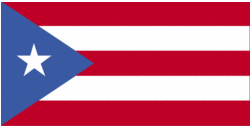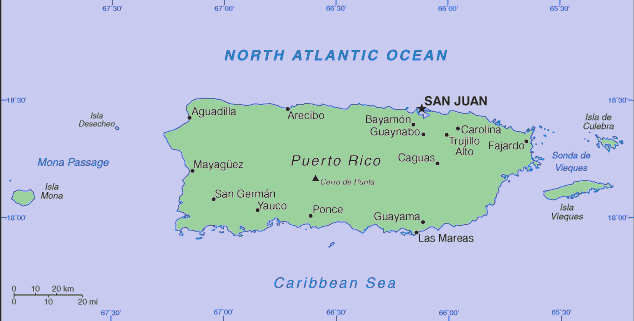Traveling Luck for Puerto Rico. Puerto Rico, North America
Puerto Rico is located in Caribbean, island between the Caribbean Sea and the North Atlantic Ocean, east of the Dominican Republic.
Land in Puerto Rico is mostly mountains with coastal plain belt in north; mountains precipitous to sea on west coast; sandy beaches along most coastal areas.
Puerto Rican land covers an area of 13790 square kilometers which is slightly less than three times the size of Rhode Island
 Puerto Rican national flag (Flag of Puerto Rico)
Puerto Rican national flag (Flag of Puerto Rico)
As for the Puerto Rican climate; tropical marine, mild; little seasonal temperature variation.
Puerto Rican(s) (US citizens) speak Spanish, English.
Places of note in Puerto Rico
- San Juan
- Bayamon Gardens
- Bayamon
- Carolina
- Ponce
- Caguas
- Guaynabo
- Mayaguez
- Trujillo Alto
- Arecibo
- Arecibo Gardens
- Fajardo
- Levittown
- Vega Baja
- Catano
- Guayama
- Humacao
- Yauco
- Cayey
- Candelaria
- Manati
- Aguadilla
- Rio Grande
- Dorado
- Isabela
- San German
- Vega Alta
- Coamo
- Hormigueros
- San Sebastian
- Corozal
- Cabo Rojo
- Utuado
- Pajaros
- Juana Diaz
 Puerto Rican map
Puerto Rican map
Populated for centuries by aboriginal peoples, the island was claimed by the Spanish Crown in 1493 following Columbus' second voyage to the Americas. In 1898, after 400 years of colonial rule that saw the indigenous population nearly exterminated and African slave labor introduced, Puerto Rico was ceded to the US as a result of the Spanish-American War. Puerto Ricans were granted US citizenship in 1917. Popularly-elected governors have served since 1948. In 1952, a constitution was enacted providing for internal self government. In plebiscites held in 1967, 1993, and 1998, voters chose not to alter the existing political status.
Puerto Rico has one of the most dynamic economies in the Caribbean region. A diverse industrial sector has far surpassed agriculture as the primary locus of economic activity and income. Encouraged by duty-free access to the US and by tax incentives, US firms have invested heavily in Puerto Rico since the 1950s. US minimum wage laws apply. Sugar production has lost out to dairy production and other livestock products as the main source of income in the agricultural sector. Tourism has traditionally been an important source of income, with estimated arrivals of nearly 5 million tourists in 2004. Growth fell off in 2001-03, largely due to the slowdown in the US economy, and has recovered in 2004-2005.
Puerto Rican natural resources include some copper and nickel; potential for onshore and offshore oil
important location along the Mona Passage - a key shipping lane to the Panama Canal; San Juan is one of the biggest and best natural harbors in the Caribbean; many small rivers and high central mountains ensure land is well watered; south coast relatively dry; fertile coastal plain belt in north
Puerto Rican religion is Roman Catholic 85%, Protestant and other 15%.
Natural hazards in Puerto Rico include periodic droughts; hurricanes.

 Search
Search Puerto Rico country profile
Puerto Rico country profile